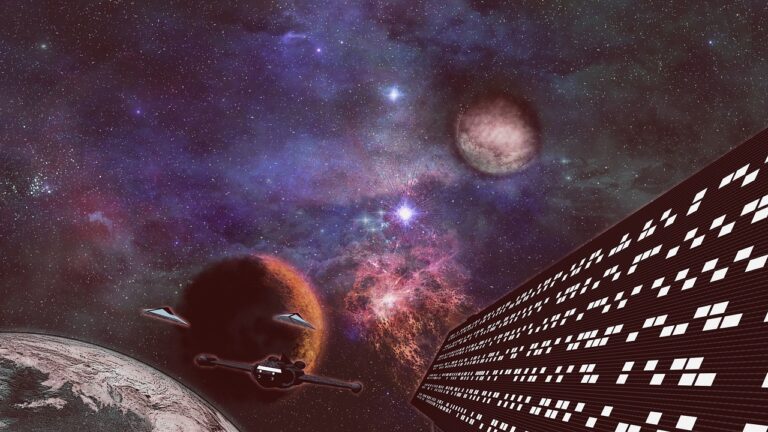In the tapestry of human progress, the intricate threads of Science Fiction often weave their way into the fabric of reality, unraveling possibilities that once seemed confined to the realm of imagination. Welcome to the juncture where Breakthroughs transcend the boundaries of the present, bringing the Future tantalizingly close. The convergence of cutting-edge innovation and the echoes of speculative fiction fuel a collective sense of wonder, propelling us into an era where the boundaries between the fantastical and the feasible blur.
The Inextricable Link: Where Science Fiction and Reality Converge
At the heart of this intriguing intersection lies the inextricable link between Science Fiction and reality. The works of visionary authors and filmmakers plant the seeds of imagination, germinating concepts that serve as blueprints for the innovators of today and tomorrow. This symbiotic relationship between fiction and fact shapes our understanding of the world, pushing the boundaries of what we dare to envision.
Consider the concept of artificial intelligence, a staple of Science Fiction narratives for decades. Today, this once-fantastical notion has materialized into sophisticated neural networks capable of learning, reasoning, and even mirroring aspects of human cognition. The once-distant future is now palpably close, as breakthroughs in machine learning bridge the gap between speculative fiction and real-world innovation.
Quantum Leaps: From Page to Prototype
The journey from Science Fiction to reality is often marked by quantum leaps that defy conventional expectations. Breakthroughs emerge, unveiling technologies that once existed solely within the realm of the imaginary. These leaps resonate with the echoes of speculative tales, prompting us to question whether we are witnessing the fulfillment of prophecies born from the minds of storytellers.
Imagine a world where teleportation is not confined to the pages of a novel but is a burgeoning field of scientific exploration. Quantum teleportation, a phenomenon rooted in the entanglement of particles, hints at the potential for instantaneous information transfer across vast distances. As researchers inch closer to realizing this once-fantastic vision, the boundaries between the extraordinary and the everyday blur, evoking a sense of awe and anticipation.
Cosmic Reverberations: Exploring the Universe and Beyond
Science Fiction has long been a vessel for humanity’s fascination with the cosmos, beckoning us to explore the stars and unravel the mysteries of the universe. Breakthroughs in space exploration and astronomy amplify this cosmic curiosity, aligning reality with the far-reaching aspirations of speculative narratives.
Consider the discovery of exoplanets, celestial bodies orbiting distant stars. This revelation echoes the imaginings of science fiction sagas, where otherworldly landscapes and extraterrestrial civilizations populate the pages. As astronomers identify habitable zones and exoplanetary potential, the veil between the terrestrial and the interstellar grows thinner, making the prospect of encountering other lifeforms feel closer than ever before.
Biotechnological Odyssey: Sculpting the Future of Life
The canvas of Science Fiction often depicts the ethereal artistry of biotechnology, where genetic manipulation and biologically engineered wonders reign supreme. Breakthroughs in genomics and gene editing have begun to sculpt this Future, offering a glimpse into a world where the boundaries of life itself are redefined.
Imagine a scenario where genetic diseases are eradicated not through fictional magic, but through the precision of CRISPR-Cas9 gene-editing technology. This biotechnological marvel, derived from the immune systems of bacteria, holds the potential to rewrite the script of human health. As researchers explore its applications, the lines between science fiction and scientific reality blur, inviting us to envision a future where genetic maladies are vanquished.
Nanotechnological Realms: Crafting on a Molecular Scale
Within the intricate web of Science Fiction lies the promise of nanotechnology, a realm where manipulation occurs on a scale so minuscule that it defies traditional comprehension. Breakthroughs in nanoscience propel us toward this microcosmic frontier, where the Future unfolds with breathtaking intricacy.
Consider the concept of nanobots coursing through our bodies, repairing tissues and eradicating diseases from within. These microscopic machines, reminiscent of science fiction tales, are becoming a tangible reality as advancements in nanotechnology pave the way for transformative medical interventions. As the boundaries between the macroscopic and the nanoscale dissolve, the potential for medical marvels that once existed solely in fiction becomes increasingly plausible.
Digital Dreams: Augmented Realities and Virtual Horizons
The digital landscapes of Science Fiction have inspired generations to envision augmented realities and virtual realms that transcend the confines of the physical world. Breakthroughs in virtual reality (VR) and augmented reality (AR) technologies are now steering us closer to these envisioned frontiers, where the Future beckons with immersive possibilities.
Imagine a world where digital overlays seamlessly blend with the physical environment, enriching our perception and interaction with the world around us. Augmented reality glasses, resembling the headsets of speculative narratives, offer a glimpse into this Future, where information and digital content become integral components of our daily lives. The convergence of virtual and actual worlds evokes a sense of wonder, bridging the gap between fiction and reality.
Ethical Crossroads: Navigating the Implications
As the realms of Science Fiction and reality intertwine, we find ourselves at an ethical crossroads, contemplating the implications of these transformative breakthroughs. The narratives of speculative fiction often explore the moral dilemmas and societal repercussions of scientific advancements, guiding us to question the balance between progress and responsibility.
Consider the advent of artificial


